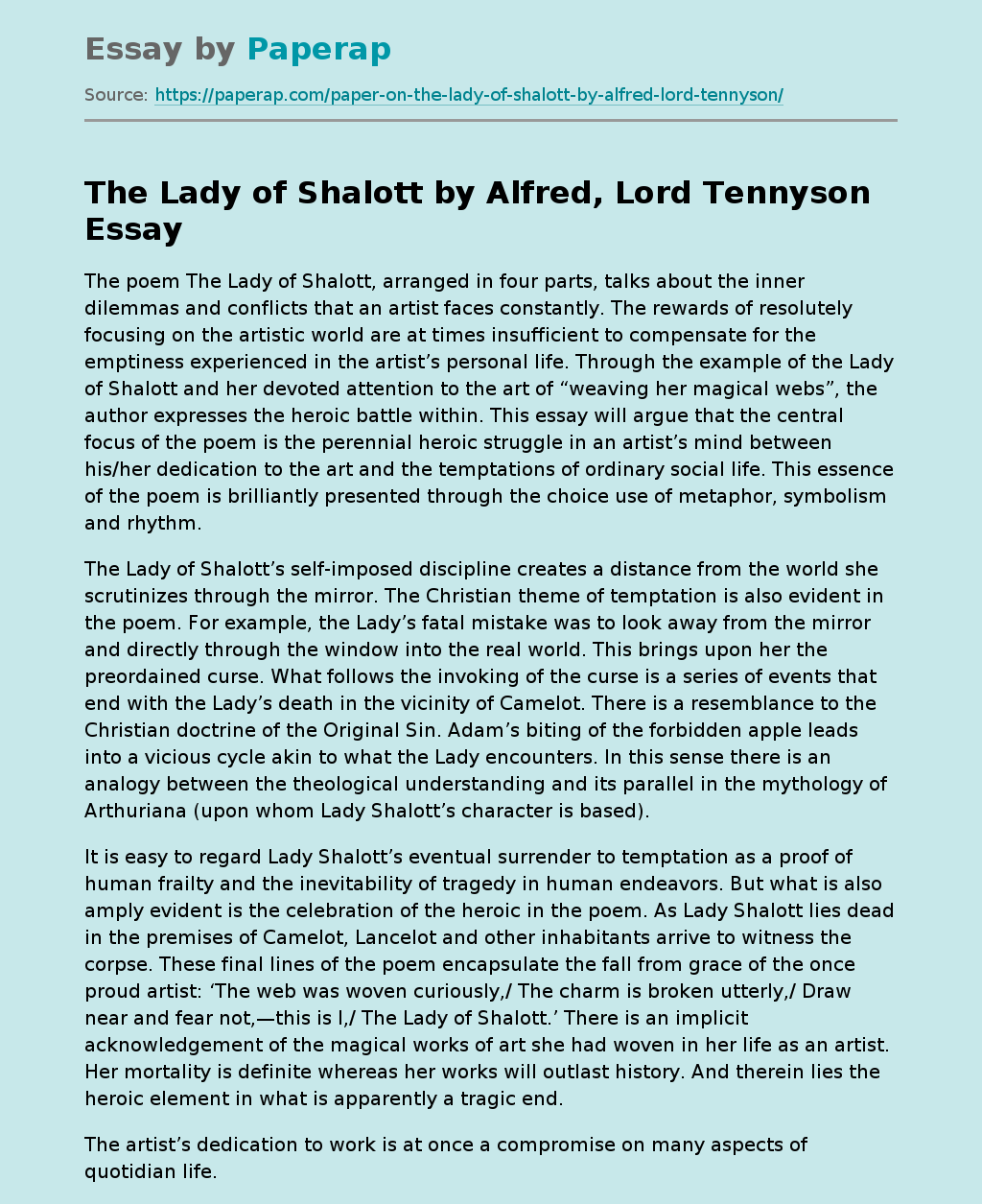The Lady of Shalott by Alfred, Lord Tennyson
The poem The Lady of Shalott, arranged in four parts, talks about the inner dilemmas and conflicts that an artist faces constantly. The rewards of resolutely focusing on the artistic world are at times insufficient to compensate for the emptiness experienced in the artist’s personal life. Through the example of the Lady of Shalott and her devoted attention to the art of “weaving her magical webs”, the author expresses the heroic battle within. This essay will argue that the central focus of the poem is the perennial heroic struggle in an artist’s mind between his/her dedication to the art and the temptations of ordinary social life.
This essence of the poem is brilliantly presented through the choice use of metaphor, symbolism and rhythm.
The Lady of Shalott’s self-imposed discipline creates a distance from the world she scrutinizes through the mirror. The Christian theme of temptation is also evident in the poem. For example, the Lady’s fatal mistake was to look away from the mirror and directly through the window into the real world.
This brings upon her the preordained curse. What follows the invoking of the curse is a series of events that end with the Lady’s death in the vicinity of Camelot. There is a resemblance to the Christian doctrine of the Original Sin. Adam’s biting of the forbidden apple leads into a vicious cycle akin to what the Lady encounters. In this sense there is an analogy between the theological understanding and its parallel in the mythology of Arthuriana (upon whom Lady Shalott’s character is based).
It is easy to regard Lady Shalott’s eventual surrender to temptation as a proof of human frailty and the inevitability of tragedy in human endeavors. But what is also amply evident is the celebration of the heroic in the poem. As Lady Shalott lies dead in the premises of Camelot, Lancelot and other inhabitants arrive to witness the corpse. These final lines of the poem encapsulate the fall from grace of the once proud artist: ‘The web was woven curiously,/ The charm is broken utterly,/ Draw near and fear not,—this is I,/ The Lady of Shalott.’ There is an implicit acknowledgement of the magical works of art she had woven in her life as an artist. Her mortality is definite whereas her works will outlast history. And therein lies the heroic element in what is apparently a tragic end.
The artist’s dedication to work is at once a compromise on many aspects of quotidian life. In order to be able to produce works of art that contain insight, intelligence and an aesthetic sense, it is necessary to remain at a distance to the world that is being captured in the art work. This distance gives the artist the requisite vantage position from which he can gain fresh perspectives on life, society and institutions. In order to gain this advantage, the artist sacrifices casual involvement with the society and its trappings which are the objects of her study. Depictions such as “Four gray walls, and four gray towers” suggest the degree of monotony that the artist must go through. The creative process that produces a brilliant work of art (the woven tapestry in the case of Lady of Shalott) also includes the artist’s rigid focus and discipline. The imagery of the “four gray walls and four gray towers” bring out aspects of the monotony and the hermit-like focus that is a pre-requisite for artistic accomplishment.
The structural aspects of The Lady of Shalot hold a resemblance to oral folklore poetry, the latter usually built on themes of the heroic struggle. Embracing the projection of the heroic as in Homer’s Odysseus and the early medieval work Boewulf, Tennyson succeeds in highlighting the virtues and fortitude of Lady of Shalott, despite her eventual decline. The technical features of the poem such as its meter and rhythm help in bringing out this essense. Another stand out aspect of the poem is it’s musical quality. A notable difference is that while conventional folk songs will have an upbeat tone about a pleasant experience, The Lady of Shalott has a melancholy tone with a tragic end.
Another literary device employed by Tennyson in depicting the inner conflict of the artist is the thematic arrangement of the four stanzas. The first half of the poem represent the passive side to a artist’s life – one where she as managed to resist worldly temptations and remain true to her art. In the second half, this grip is loosened, hastening a quick succession of events that would lead to her demise. Appropriately, this half of the poem is markedly more lively and the imagery is more vivid: “A bow-shot from her bower-eaves,/He rode between the barley-sheaves,/The sun came dazzling thro’ the leaves,/And flamed upon the brazen greaves/Of bold Sir Lancelot.”Equally important in the transition from the static, quiet ambience to the whirlwind unfolding of events in the second half is the tense employed by Tennyson. The lack of control of the Lady of Shalott over her own destiny (upon invoking the curse) and the maddening rush of unfortunate events leading up to her death is best illustrated by the repetitive usage of ‘she’ in the third part of the poem: “She left the web, she left the loom,/She made three paces thro’ the room,/She saw the water-lily bloom,/She saw the helmet and the plume,/She look’d down to Camelot.”
The Lady of Shalott by Alfred, Lord Tennyson. (2019, Feb 26). Retrieved from https://paperap.com/paper-on-the-lady-of-shalott-by-alfred-lord-tennyson/

